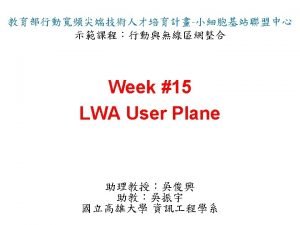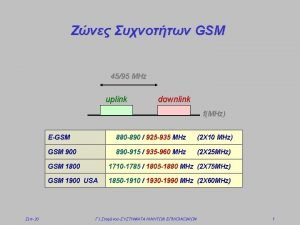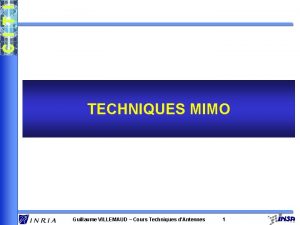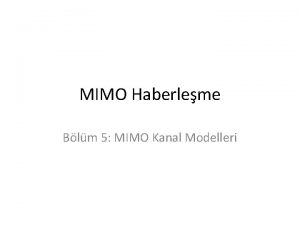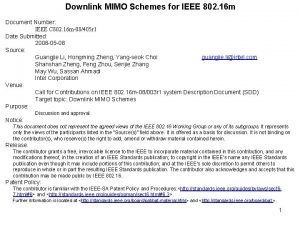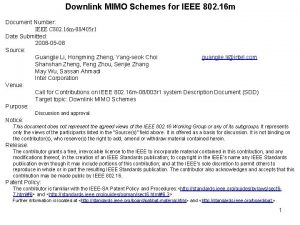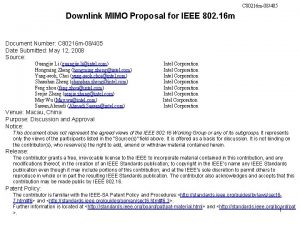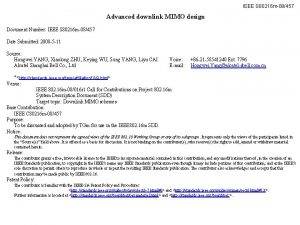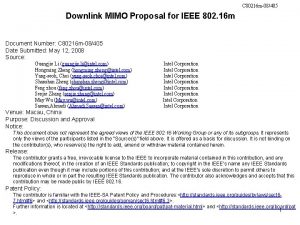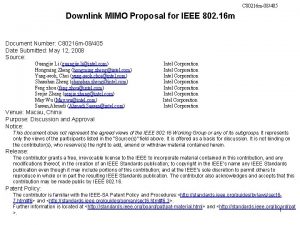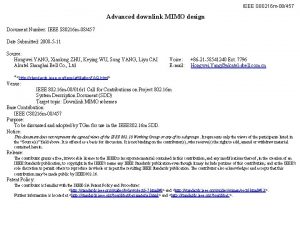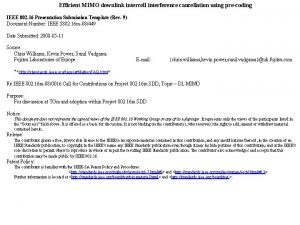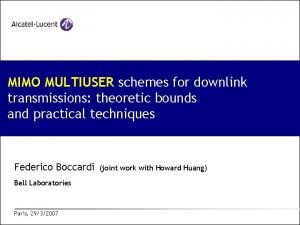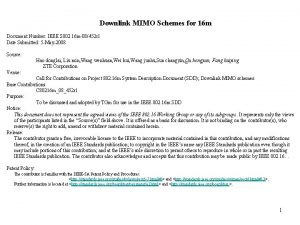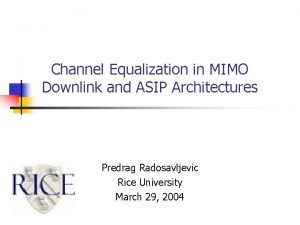Downlink Singleuser MIMO Comparison for IEEE 802 16















![Appendix • Reference documents [1] IEEE P 802. 16 Rev 2/D 1, “IEEE Standard Appendix • Reference documents [1] IEEE P 802. 16 Rev 2/D 1, “IEEE Standard](https://slidetodoc.com/presentation_image/2cf159e1c9051ea1b381f43d0702662e/image-16.jpg)
- Slides: 16

Downlink Single-user MIMO Comparison for IEEE 802. 16 m Document Number: IEEE C 802. 16 m-08/407 r 1 Date Submitted: 2008 -05 -08 Source: Senjie Zhang, guangjie Li, Hongming Zheng senjie. zhang@intel. com Yang-Seok Choi, Shanshan Zheng, Feng Zhou May Wu, Minnie Ho, Sassan Ahmadi Intel Corporation Venue: Call for Contributions on IEEE 802. 16 m-08/003 r 1 system Description Document (SDD) Target topic: Downlink MIMO Schemes Purpose: Discussion and approval Notice: This document does not represent the agreed views of the IEEE 802. 16 Working Group or any of its subgroups. It represents only the views of the participants listed in the “Source(s)” field above. It is offered as a basis for discussion. It is not binding on the contributor(s), who reserve(s) the right to add, amend or withdraw material contained herein. Release: The contributor grants a free, irrevocable license to the IEEE to incorporate material contained in this contribution, and any modifications thereof, in the creation of an IEEE Standards publication; to copyright in the IEEE’s name any IEEE Standards publication even though it may include portions of this contribution; and at the IEEE’s sole discretion to permit others to reproduce in whole or in part the resulting IEEE Standards publication. The contributor also acknowledges and accepts that this contribution may be made public by IEEE 802. 16. Patent Policy: The contributor is familiar with the IEEE-SA Patent Policy and Procedures: <http: //standards. ieee. org/guides/bylaws/sect 6 -7. html#6> and <http: //standards. ieee. org/guides/opman/sect 6. html#6. 3>. Further information located at <http: //standards. ieee. org/board/pat-material. html> and <http: //standards. ieee. org/board/pat >. 1

Outline • • • Overview Open-loop Schemes Closed-loop Schemes Comparison between SCW and MCW Summary and Recommendations 2

Overview • • Single-user MIMO is to improve per link performance in terms of high data rate and good coverage Design criteria and requirements – – – • Evaluate and select schemes in 802. 16 e spec[1] to make 802. 16 m solution concise and effective Improve 802. 16 e existing schemes if possible Low system complexity Support Single Codeword (SCW) Evaluate if there is obvious gain from MCW over SCW especially with MLD receiver 802. 16 e Scheme Overview – Open-loop • For 2 -TX, STBC (matrix A) for rate 1 and Spatial Multiplexing (matrix B) for rate 2 • For 4 -TX, STBC (matrix A) for rate 1 and hybrid STBC/SM (matrix B) for rate 2. They are with antenna hopping • Cyclic delay diversity (CDD)[2] – Closed-loop • Antenna grouping/ selection • Codebook-based precoding • Sounding-based precoding 3

Open-loop Schemes • 2 -TX schemes – In IEEE STD 802. 16 e specification, STBC such as Alamouti code is supported to provide spatial diversity and reduce fade margin. Spatial multiplexing is also supported to take advantage of higher peak rates and increased throughput – The 2 -antenna rate 1 scheme is a basic STC scheme, enabled by matrix A – The 2 -antenna rate 2 scheme is enabled by matrix B – 2 -TX STBC/SM is legacy MIMO mode in 802. 16 e reference system, and should be supported in 802. 16 m. 4

Open-loop Schemes (Cont. ) • 4 -TX Matrix A/B with antenna hopping – applying A 1~A 3 or B 1~B 6 periodically • CDD[3] – Same process to pilot and data – Same power on Physical antenna – Combined with STBC or SM 5

Open-loop Scheme Performance • CDD has <1 d. B performance loss with non-ideal CE 6

Open-loop Scheme Summary • CDD vs. AH – Pros • Low transmitter complexity: Only ‘copy and shift’ operation • Low receiver complexity: For MMSE receiver, AH requires 4 x 4 matrix inversion, CDD requires 2 x 2 only • Small pilot overhead • Simple channel estimation: CDD uses same pilot pattern with 2 -TX systems – Cons • <1 d. B performance loss with non-ideal CE • Channel estimator’s coefficients need be adaptive to cyclic delay value • Open-loop summary – Support STBC/SM – CDD+STBC/SM is good candidate for asymmetric antenna configuration e. g. 4 x 2 – Antenna hopping is more complicated in receiver side than CDD, and need twice of the pilot though about 1 d. B better 7

Closed-loop Schemes • 802. 16 e’s Antenna Grouping for 4 -TX antenna is – To choose the best matrix from A 1~A 3 or B 1~B 6 as described in page 5 – equivalent to precoding with the simplest W matrix (elements is 0 or 1) • Antenna Selection for 4 -TX antenna is – To choose best antenna(s) from 4 -TX antenna and apply power boosting – equivalent to precoding with the simplest W matrix (elements is 0 or 1) 8

Closed-loop Schemes • 802. 16 e provides a set of codebooks based on Grassmann subspace packing – For example, the 3 -bit codebook for 4 -TX rate 1 is: – Newly-designed codebooks can be evaluated for improvement • Sounding-based solution requires careful study[4] – – CQI is still needed because DL interference is unknown RF calibration issue Uplink interference’s impact Other pending issues 9

Closed-loop Scheme Performance • For rate-1 schemes, codebook-based precoding provides best performance – Best approaching to perfect feedback – 5 d. B better than open-loop – 1~2. 5 d. B better than AG/AS with comparable feedback 10

Closed-loop Scheme Performance (Cont. ) • For rate-2 schemes, codebook-based precoding provides best performance – Best approaching to perfect feedback – 5 d. B better than open-loop – 1~2. 5 d. B better than AG/AS with comparable feedback 11

Closed-loop/ Open-loop Performance Comparison • Codebook closedloop is better than open-loop: With non-ideal CE and MLD receiver, it still has 3~4 d. B’s performance gain 12

Closed-loop Scheme Summary • Codebook vs. AG/AS – Codebook provides better approaching to perfect feedback – With comparable feedback (Codebook: 3 bits, AG/AS: 2 bits), codebook has 1~2 d. B gain – Antenna selection is not good in terms of TX power balance • Codebook vs. Sounding [4] – RF Calibration is required – Difficult for wideband sounding – CQI still needed to be fed back • Closed-loop Summary – Recommend to support codebook-based precoding 13

Comparing Single Codeword (SCW) & Multiple Codeword (MCW) • SCW is simple and with less feedback overhead • MCW provides better adaptation to channel condition, but requires more CQI feedback and is more complicated than SCW – MCW can utilize SIC receiver to improve its performance. MCW+SIC receiver can outperform SCW+MMSE receiver, but it has little gain over SCW+MLD receiver. As the following figure shows. • Summary: Support Single Codeword (SCW) 14

Single-user MIMO Comparison and Summary Use Open-loop (OL) and Closed-loop (CL) for different scenarios - OL: high speed - CL: medium/low speed • Example Antenna Configuration Open-loop Closed-Loop 2 x 2 STBC/SM Codebook precoding 4 x 2 Antenna Hopping CDD+STBC/SM Antenna selection Antenna Grouping Codebook precoding Open-loop – Support STBC/SM to backward compatible to 802. 16 e reference system – Recommend to support CDD+STBC/SM for asymmetric antenna configuration e. g. 4 x 2 • • • Low complexity in both Tx and Rx side Good performance Small pilot overhead for asymmetric antenna configuration – Antenna Hopping is more complicated in receiver side than CDD, and need twice of the pilot • Closed-loop – Recommend to support codebook based solution – Antenna selection is not good in terms of power utilization issue 15
![Appendix Reference documents 1 IEEE P 802 16 Rev 2D 1 IEEE Standard Appendix • Reference documents [1] IEEE P 802. 16 Rev 2/D 1, “IEEE Standard](https://slidetodoc.com/presentation_image/2cf159e1c9051ea1b381f43d0702662e/image-16.jpg)
Appendix • Reference documents [1] IEEE P 802. 16 Rev 2/D 1, “IEEE Standard for Local and metropolitan area networks Part 16: Air Interface for Fixed and Mobile Broadband Wireless Access Systems, ” 2007 [2] Wi. MAX Forum Technical Working Group, “RPD recommandations for CDD usage ”, 2007 [3] C 80216 maint-08_006, “Definitions for transparent transmit diversity”, 2008 [4] Intel, ““DL_MIMO_Proposal_08 xx”, 2008 • Simulation settings – – – – 16 x 6 RB size e. ITU-Ped. B 3 Km/h CTC ½ coding rate QPSK, 16 QAM, 64 QAM MMSE, MLD and SIC receiver Ideal CE or non-ideal CE using LMMSE estimator 16
 Downlink data delivery status
Downlink data delivery status 73mod26
73mod26 Bridges from 802.x to 802.y
Bridges from 802.x to 802.y Bridges from 802.x to 802.y
Bridges from 802.x to 802.y Arquitetura ieee 802
Arquitetura ieee 802 Modelo ieee 802
Modelo ieee 802 Ieee 802 standard
Ieee 802 standard Bluetooth ieee 802
Bluetooth ieee 802 802 ieee
802 ieee Ieee 802
Ieee 802 Ieee 802 family
Ieee 802 family Ieee 802 3 compliance
Ieee 802 3 compliance Ieee 802
Ieee 802 (mackenzie) não caracteriza a estética parnasiana: *
(mackenzie) não caracteriza a estética parnasiana: * Cours mimo
Cours mimo Mimi urbani teocrito
Mimi urbani teocrito Mayamimo
Mayamimo
